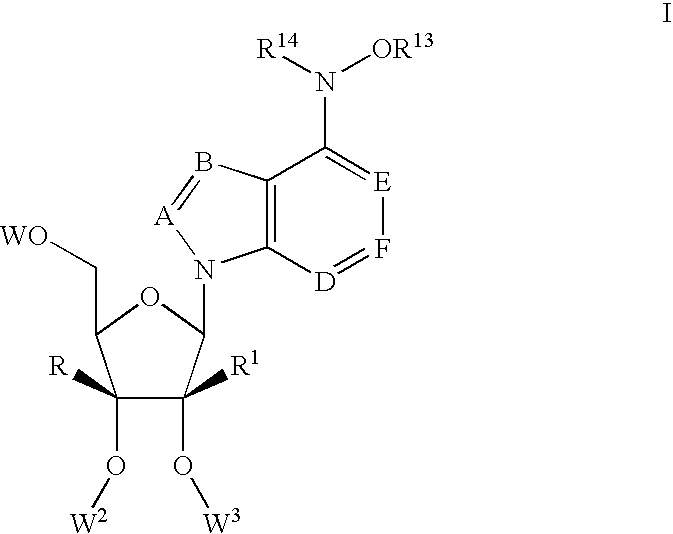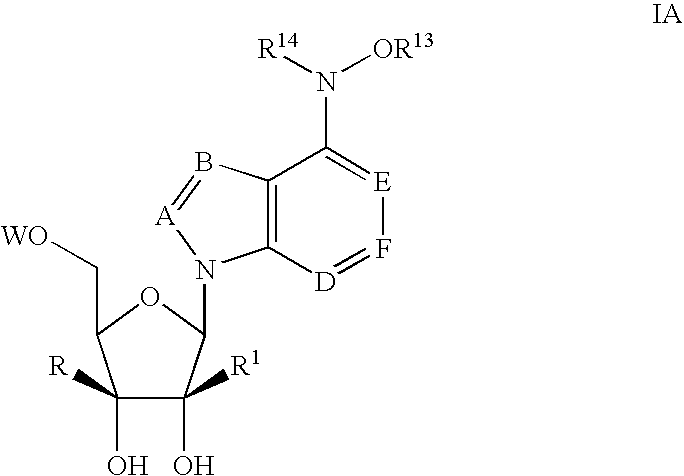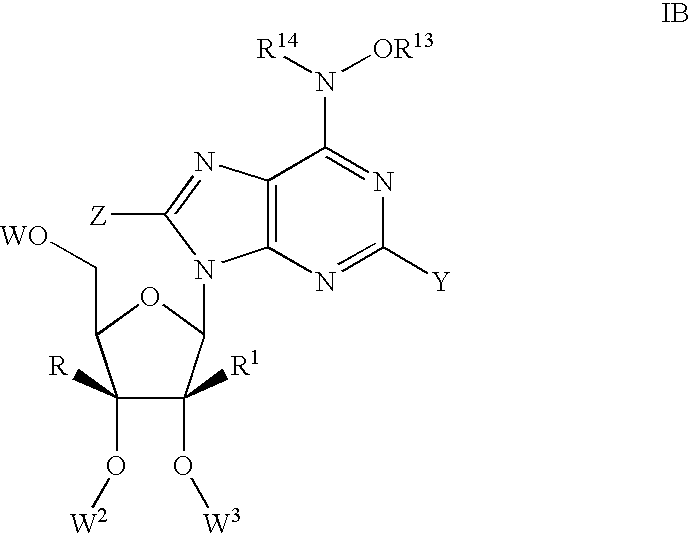Nucleoside derivatives for treating hepatitis C virus infection
a technology of hepatitis c virus and nucleosides, which is applied in the direction of peptide/protein ingredients, impression caps, applications, etc., can solve the problems of liver failure or liver cancer, eventually death, and difficult treatment of hcv, and no effective immunization is currently availabl
- Summary
- Abstract
- Description
- Claims
- Application Information
AI Technical Summary
Problems solved by technology
Method used
Image
Examples
example 6
1-(2'-C-methyl-.beta.-D-ribofuranosyl)-4-hydroxylamino-pyrazolo[3,4-d]pyri-midine (120)
[0585] Step 1. Synthesis of 2,3,5-tri-O-benzoyl-2'-methyl-1,5-dihydro-pyra-zolo[3,4-d] pyrimidin-4-one (142).
[0586] Nucleoside 142 was synthesized as described in Example 1 by substitution of 6-bromopurine for 1,5-dihydro-pyrazolo[3,4-d]pyrimidin-4--one.
[0587] Step 2. Synthesis of 2,3,5-tri-O-benzoyl-2'-methyl-4-chloro-pyrazol-o[3,4-d]pyrimidine (143)
[0588] Nucleoside 142 was dissolved in toluene, 10 equivalents of SOCl.sub.2 were added and the mixture was heated at 50.degree. C. for 2 hours. The solvents were evaporated in vacuo, the residue was co-evapotated with toluene and purified by flash chromatography on silica gel (toluene-ethyl acetate, 9:1 v / v). Corresponding fractions were evaporated, dissolved in 10 mL of methanol and 5 mL NH.sub.4OH was added. Reaction mixture was kept at room temperature overnight and evaporated. The titled nucleoside was isolated by HPLC as described in Example 3, ...
example 7
1-(2'-C-methyl-.beta.-D-ribofuranosyl)-4-methoxylamino-pyrazolo[3,4-d]pyri-midine (119)
[0591] Nucleoside 119 was prepared from the nucleoside 143 (Example 6, step 3) substituting hydroxylamine for methoxylamine.
example 8
7-(2'-C-methyl-.beta.-D-ribofuranosyl)-5-chloro-4-hydroxylamino-pyrrolo[2,-3-d]pyrimidine (123)
[0592] Nucleoside 117 (0.1 mmol) is dissolved in DMF (0.5 mL) and cooled to 0.degree. C. NCS (0.1 mmol) dissolved in DMF (0.5 mL) is then added dropwise and the reaction stirred for 30 minutes at 0.degree. C. and 30 minutes at room temperature. The reaction is quenched with methanol (5 mL) and then concentrated. Column chromatography (SiO.sub.2) with MeOH / DCM affords 123.
PUM
| Property | Measurement | Unit |
|---|---|---|
| Mass | aaaaa | aaaaa |
| Mass | aaaaa | aaaaa |
| Mass | aaaaa | aaaaa |
Abstract
Description
Claims
Application Information
 Login to View More
Login to View More - R&D
- Intellectual Property
- Life Sciences
- Materials
- Tech Scout
- Unparalleled Data Quality
- Higher Quality Content
- 60% Fewer Hallucinations
Browse by: Latest US Patents, China's latest patents, Technical Efficacy Thesaurus, Application Domain, Technology Topic, Popular Technical Reports.
© 2025 PatSnap. All rights reserved.Legal|Privacy policy|Modern Slavery Act Transparency Statement|Sitemap|About US| Contact US: help@patsnap.com



